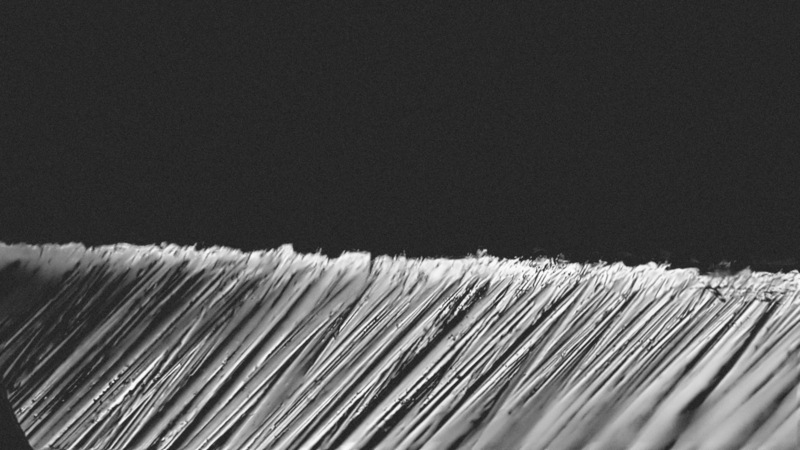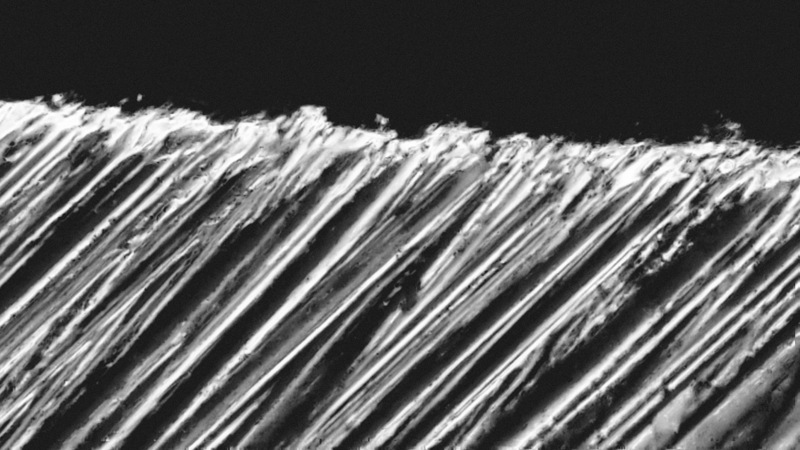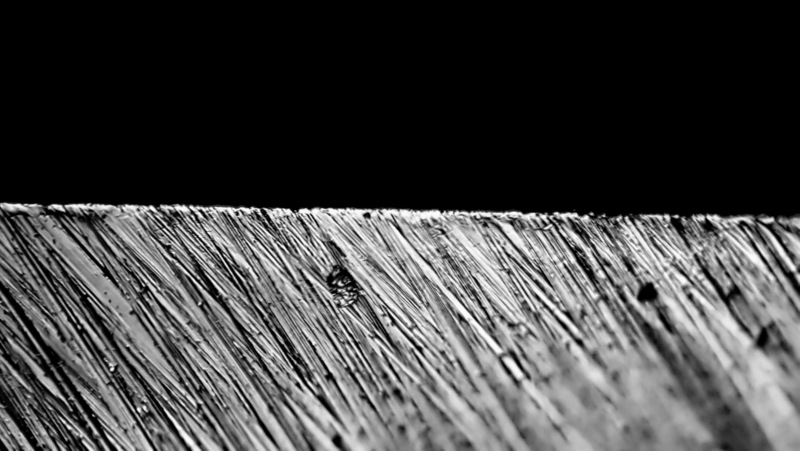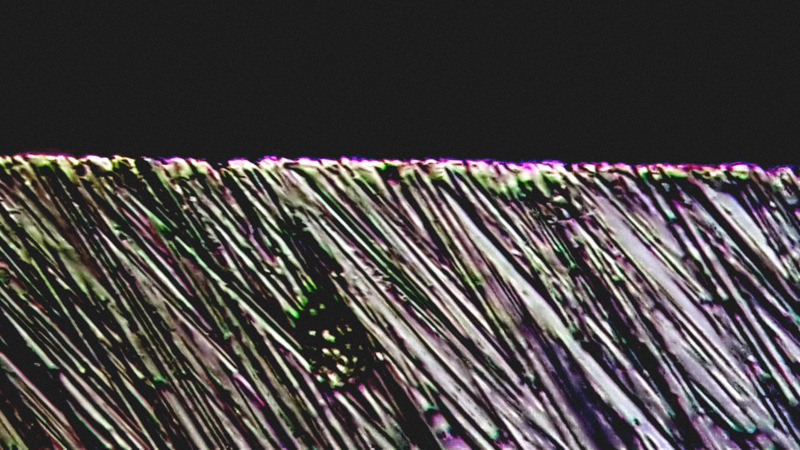Edge leading VS. Edge trailing under Magnification
Recent › Forums › Main Forum › Off Topic › Edge leading VS. Edge trailing under Magnification
- This topic has 11 replies, 9 voices, and was last updated 05/23/2016 at 4:04 pm by
CliffCurry.
-
AuthorPosts
-
05/22/2016 at 5:06 am #34162
I took a paring knife and sharpened it at 16dps using well worn 600 grit paddles with edge trailing and then leading strokes and documented the difference.
Edge trailing x400:

The edge leading apex had significantly more “bite” to the pad of my finger and just felt sharper, just like I learned when first starting out with the Wicked Edge. Most noticeable to me was how uniform the apex looked with no torn out sections.
The edge trailing shows wisps of metal forming burrs in places and I think my next experiments will be documenting burrs and what damage happens when we remove them using different methods.
Attachments:
You must be logged in to access attached files.
8 users thanked author for this post.
05/22/2016 at 6:49 am #34175Thanks! This seems to be consistent with similar experiments we have seen here (by Clay?).
Molecule Polishing: my blog about sharpening with the Wicked Edge
05/22/2016 at 7:03 am #34178I think my next experiments will be documenting burrs and what damage happens when we remove them using different methods.
Looking forward to it.
05/22/2016 at 8:33 am #34181Outstanding!
Eddie Kinlen
M1rror Edge Sharpening Service, LLC
+1(682)777-162205/22/2016 at 8:37 am #34182Love the pics….
Did the Edge Leading feel sharper to your finger with both a push stroke and a draw stroke?
Would it make a difference if it were a Edge Leading stroke from tip to heel versus Edge Leading from heel to tip?
Is my old eyes or does the Edge Leading look like it leaves a more “uniform” tooth pattern with less chaotic looking edge? I did this to try to see things better… not that it helped…
Thanks all you guys for pushing the envelope….
~~~~
For Now,Gib
Φ
"Everyday edge for the bevel headed"
"Things work out best for those who make the best out of the way things work out."
Attachments:
You must be logged in to access attached files.
05/22/2016 at 9:48 am #34186The difference is impressive and seems counterintuitive ($5 word of the day) to what I would think. What would ever be the reason for using edge trailing strokes?
05/22/2016 at 10:48 am #34188What would ever be the reason for using edge trailing strokes?
Toothier edge for kitchen knives?
Alan
05/22/2016 at 11:12 am #34189This is peer confirmation of the observations made in Todds Blog (Science of Sharp, 2015) Click (Here) to review part one and (Here) to review part two. The Scanning Electron Microscope (SEM) images have been out in the public for some time now. Todd also discusses prevention of a burr and removal (Here). His focus was on razor blades, however, his work applies to all blades. If you haven’t read it, I believe it is worth it to read every word.
 Todd also discusses edge leading and edge trailing (Here)
Todd also discusses edge leading and edge trailing (Here)Eddie Kinlen
M1rror Edge Sharpening Service, LLC
+1(682)777-16224 users thanked author for this post.
05/22/2016 at 11:31 am #34190I think I’m one of clay’s first converts to Edge-Leading, but when I transition from my diamond stones to my diamond film, I go to Edge-trailing, simply to prevent film cuts. I’m thinking (hoping, actually) that the film grits are fine enough to not cause those evil breakouts.
And yes, if I really wanted a toothier edge, Edge-Trailing is one way to get there. It seems to make sense that 600-grit used Edge-Leading will create a “toothy” edge, but 600-grit used Edge-Trailing would also leave a random number of deeper teeth.
Cliff: Are you turning into one of us “late-night” denizens of the forum? BTW, what were the two different grits you used in your photos? To fairly judge the differences in the edge breakouts, you should really use the same stones.
3 users thanked author for this post.
05/22/2016 at 5:06 pm #34194Cliff: Are you turning into one of us “late-night” denizens of the forum? BTW, what were the two different grits you used in your photos? To fairly judge the differences in the edge breakouts, you should really use the same stones.
Toy Ive always been a late night guy, and then you have the time zone to consider. I ususally am posting about midnight(3am pacific tz).
Sorry if it looks like I used different stones. All the above were done with the same 600 grit paddles. Its just the digital zoom is set to slight different magnification….something to really try to avoid in the future for a clear comparision. The edge trailing leaves metal at the apex I guess you could call toothier but they are more just of the foil burr variety.
Edge leading strokes leave just the classic toothy grooved edge that is clean and strong.Did the Edge Leading feel sharper to your finger with both a push stroke and a draw stroke? Would it make a difference if it were a Edge Leading stroke from tip to heel versus Edge Leading from heel to tip? Is my old eyes or does the Edge Leading look like it leaves a more “uniform” tooth pattern with less chaotic looking edge? I did this to try to see things better… not that it helped…
Because I went heel towards tip on the downward edge leading strokes the “bite” is much more significant when pulling back against the angle of the teeth, and as I was saying to Tom its much more uniform.
Burr removal observations will definitely be next. Just when doing initial setups and testing I had observed a foil burr that when ran over a softish medium(like plastic or wood) the burr was removed but it ripped out chunks of the apex as well. Whether or not further stropping and refinement makes this a non-issue is one of the questions.
05/23/2016 at 3:30 pm #34204Great job Cliff, love your new scope =)
One thing I would like to see documented, which would likely require an SEM, is well worn stones vs. barely “broken in” stones and if the former would allow for a full burr removal or just push it back and forth. The reason for the question is because my thought is that, as Clay stated these types of diamonds are the ones that do not fracture but wear instead (paraphrasing…) the “duller” diamonds would not cut the burr off like fresh sharp diamonds would. May be completely off base here, just a probing thought!
Keep up the great work!
05/23/2016 at 4:04 pm #34205Great job Cliff, love your new scope =) One thing I would like to see documented, which would likely require an SEM, is well worn stones vs. barely “broken in” stones and if the former would allow for a full burr removal or just push it back and forth. The reason for the question is because my thought is that, as Clay stated these types of diamonds are the ones that do not fracture but wear instead (paraphrasing…) the “duller” diamonds would not cut the burr off like fresh sharp diamonds would. May be completely off base here, just a probing thought! Keep up the great work!
Josh, its not ideal but I do have 2 sets of the 100/200 paddles, one set brand new & the other extremely worn in. Would that work to compare?
In the above I just took my very well worn 400/600 and did edge trailing until apexed, took pictures, then reclamped and did edge leading. The edge leading removed all the burr created by edge trailing without extra steps or effort, or so it would appear. -
AuthorPosts
- You must be logged in to reply to this topic.



